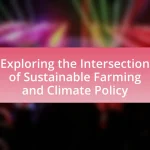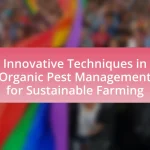Regenerative agriculture is a sustainable farming practice aimed at restoring soil health, enhancing biodiversity, and improving ecosystem resilience. This article explores key takeaways from recent conferences on regenerative agriculture, highlighting its principles, differences from traditional farming, and its role in addressing environmental challenges such as climate change and biodiversity loss. It discusses innovations in practices, the impact of technology and community collaboration, and the economic factors influencing the adoption of regenerative methods. Additionally, the article outlines actionable strategies for farmers and emphasizes the importance of consumer support in promoting regenerative agriculture initiatives.

What is Regenerative Agriculture?
Regenerative agriculture is a farming practice that focuses on restoring and enhancing the health and biodiversity of ecosystems while improving soil health and increasing agricultural productivity. This approach emphasizes techniques such as cover cropping, crop rotation, agroforestry, and reduced tillage, which contribute to carbon sequestration and improved water retention. Research indicates that regenerative agriculture can lead to a 30% increase in soil organic matter, which enhances soil fertility and resilience against climate change.
How does Regenerative Agriculture differ from traditional farming methods?
Regenerative Agriculture focuses on restoring and enhancing soil health, biodiversity, and ecosystem services, while traditional farming methods often prioritize maximum yield and short-term productivity. Regenerative practices include crop rotation, cover cropping, and reduced tillage, which improve soil structure and fertility over time. In contrast, traditional farming frequently relies on synthetic fertilizers and pesticides, which can degrade soil health and reduce biodiversity. Research indicates that regenerative practices can sequester carbon in the soil, potentially mitigating climate change, whereas traditional methods may contribute to greenhouse gas emissions.
What principles define Regenerative Agriculture?
Regenerative Agriculture is defined by principles that focus on enhancing soil health, increasing biodiversity, and improving ecosystem resilience. These principles include practices such as cover cropping, crop rotation, reduced tillage, and integrating livestock into cropping systems. For instance, cover cropping helps prevent soil erosion and enhances soil organic matter, while crop rotation disrupts pest cycles and improves nutrient cycling. Research indicates that these practices can lead to increased yields and carbon sequestration, demonstrating their effectiveness in promoting sustainable agricultural systems.
How does soil health play a role in Regenerative Agriculture?
Soil health is fundamental to Regenerative Agriculture as it enhances biodiversity, improves water retention, and increases nutrient cycling. Healthy soil supports a diverse ecosystem of microorganisms, which contribute to plant growth and resilience against pests and diseases. Research indicates that practices such as cover cropping and reduced tillage can significantly improve soil organic matter, leading to better soil structure and fertility. For instance, a study published in the journal “Agriculture, Ecosystems & Environment” by Teague et al. (2016) found that regenerative practices can increase soil carbon levels, which is crucial for long-term sustainability and productivity in agricultural systems.
Why is Regenerative Agriculture gaining attention in recent years?
Regenerative Agriculture is gaining attention in recent years due to its potential to enhance soil health, increase biodiversity, and combat climate change. This agricultural approach focuses on practices that restore and maintain ecological balance, such as cover cropping, crop rotation, and reduced tillage. Research indicates that regenerative practices can sequester carbon in the soil, with studies showing that they can capture up to 1.1 billion tons of carbon dioxide annually in the U.S. alone. Additionally, the increasing awareness of food systems’ impact on the environment and the demand for sustainable farming practices have further propelled interest in regenerative agriculture.
What environmental challenges does Regenerative Agriculture address?
Regenerative Agriculture addresses several environmental challenges, including soil degradation, biodiversity loss, and climate change. This agricultural approach focuses on restoring soil health through practices such as cover cropping, crop rotation, and reduced tillage, which enhance soil structure and fertility. Research indicates that regenerative practices can increase soil organic matter by up to 1% per year, significantly improving carbon sequestration and reducing greenhouse gas emissions. Additionally, by promoting diverse cropping systems, Regenerative Agriculture helps to restore habitats for various species, thereby combating biodiversity loss.
How does Regenerative Agriculture contribute to climate change mitigation?
Regenerative agriculture contributes to climate change mitigation by enhancing soil health and increasing carbon sequestration. This farming approach employs practices such as cover cropping, reduced tillage, and agroforestry, which improve soil structure and fertility, allowing for greater carbon storage in the soil. Research indicates that regenerative practices can sequester up to 1.1 billion metric tons of carbon dioxide annually in the United States alone, significantly reducing greenhouse gas emissions. Additionally, healthier soils improve resilience to climate impacts, further supporting climate adaptation efforts.

What were the key themes discussed at recent conferences on Regenerative Agriculture?
Recent conferences on Regenerative Agriculture highlighted key themes such as soil health, biodiversity, and climate resilience. Soil health was emphasized as foundational for sustainable farming practices, with discussions on techniques like cover cropping and reduced tillage that enhance soil structure and fertility. Biodiversity was addressed as essential for ecosystem stability, promoting practices that support diverse plant and animal life on farms. Climate resilience was a critical theme, focusing on how regenerative practices can mitigate climate change impacts and enhance farm adaptability. These themes reflect a growing consensus on the importance of holistic approaches to agriculture that prioritize ecological balance and sustainability.
What innovations in practices were highlighted during these conferences?
Innovations in practices highlighted during these conferences included the integration of cover cropping, agroforestry, and holistic grazing management. Cover cropping was emphasized for its ability to improve soil health and reduce erosion, while agroforestry practices were showcased for enhancing biodiversity and carbon sequestration. Holistic grazing management was presented as a method to restore grassland ecosystems and improve livestock productivity. These practices are supported by research indicating their effectiveness in promoting sustainable agricultural systems and enhancing resilience against climate change.
How are technology and data influencing Regenerative Agriculture?
Technology and data are significantly influencing regenerative agriculture by enhancing precision farming practices and improving soil health monitoring. Advanced technologies such as satellite imagery, drones, and IoT sensors enable farmers to collect real-time data on soil conditions, crop health, and environmental factors, allowing for more informed decision-making. For instance, a study published in the journal “Agricultural Systems” highlights that precision agriculture can increase crop yields by up to 20% while reducing input costs by 15%. Additionally, data analytics tools help farmers analyze historical data to identify trends and optimize resource use, further promoting sustainable practices.
What role do community and collaboration play in advancing Regenerative Agriculture?
Community and collaboration are essential in advancing Regenerative Agriculture by fostering knowledge sharing, resource pooling, and collective action among farmers and stakeholders. These interactions enable the exchange of best practices and innovative techniques, which are crucial for improving soil health and biodiversity. For instance, collaborative networks like the Regenerative Agriculture Alliance facilitate partnerships that enhance learning and implementation of regenerative practices, leading to increased resilience in agricultural systems. Furthermore, studies show that farms engaged in community-based initiatives often report higher yields and improved ecological outcomes, demonstrating the tangible benefits of collaboration in this field.
What challenges were identified in implementing Regenerative Agriculture?
Challenges identified in implementing Regenerative Agriculture include financial constraints, lack of knowledge and training, and resistance to change among farmers. Financial constraints arise from the initial investment required for transitioning to regenerative practices, which can deter farmers from adopting these methods. Lack of knowledge and training limits farmers’ ability to effectively implement regenerative techniques, as many are unfamiliar with the principles and practices involved. Additionally, resistance to change is often rooted in established farming habits and skepticism about the benefits of regenerative approaches, making it difficult to shift towards these sustainable practices.
How do economic factors impact the adoption of Regenerative practices?
Economic factors significantly influence the adoption of regenerative practices by affecting the financial viability and risk assessment of such methods. Farmers often weigh the initial investment costs against potential long-term benefits, such as improved soil health and increased crop yields. For instance, a study published in the journal “Agricultural Systems” found that regenerative practices can lead to a 10-20% increase in profitability over time, which incentivizes adoption. Additionally, access to financial resources, such as grants or low-interest loans, can facilitate the transition to regenerative agriculture, as highlighted by the USDA’s initiatives that provide funding for sustainable practices. Thus, economic considerations play a crucial role in determining whether farmers choose to implement regenerative practices.
What are the barriers to education and awareness about Regenerative Agriculture?
Barriers to education and awareness about Regenerative Agriculture include limited access to resources, lack of trained educators, and insufficient funding for outreach programs. Limited access to resources restricts farmers and communities from obtaining necessary information and tools to implement regenerative practices. The lack of trained educators hampers the dissemination of knowledge, as there are not enough experts to teach these methods effectively. Additionally, insufficient funding for outreach programs prevents the development and distribution of educational materials and workshops, which are crucial for raising awareness and understanding of regenerative agriculture.

How can stakeholders benefit from the insights shared at these conferences?
Stakeholders can benefit from the insights shared at these conferences by gaining access to the latest research, innovative practices, and networking opportunities that enhance their understanding of regenerative agriculture. These insights often include data-driven strategies that have been proven to improve soil health, increase biodiversity, and enhance crop yields, which are critical for sustainable farming. For instance, a study presented at a recent conference highlighted that farms implementing regenerative practices saw a 20% increase in productivity over three years, demonstrating the tangible benefits of these insights. Additionally, stakeholders can connect with experts and peers, fostering collaborations that can lead to the adoption of best practices and the sharing of resources, ultimately driving the advancement of regenerative agriculture initiatives.
What actionable strategies can farmers adopt from conference takeaways?
Farmers can adopt several actionable strategies from conference takeaways on regenerative agriculture, including implementing cover cropping, enhancing soil health through composting, and utilizing integrated pest management techniques. Cover cropping can improve soil structure and reduce erosion, as evidenced by studies showing that it can increase organic matter by up to 1% per year. Enhancing soil health through composting not only recycles nutrients but also boosts microbial activity, which is crucial for plant growth. Integrated pest management techniques, which combine biological, cultural, and chemical practices, have been shown to reduce pesticide use by 30% while maintaining crop yields. These strategies collectively contribute to sustainable farming practices that enhance productivity and environmental health.
How can farmers measure the success of Regenerative practices?
Farmers can measure the success of regenerative practices through various metrics such as soil health indicators, biodiversity levels, and crop yield improvements. Soil health can be assessed using tests for organic matter content, microbial activity, and nutrient availability, which have been shown to improve under regenerative practices. Biodiversity can be evaluated by monitoring the variety of plant and animal species present on the farm, as increased biodiversity is a key goal of regenerative agriculture. Additionally, farmers can track crop yields over time to determine if regenerative practices lead to enhanced productivity, with studies indicating that regenerative methods can increase yields by 10-20% compared to conventional practices.
What resources are available for farmers looking to transition to Regenerative Agriculture?
Farmers looking to transition to Regenerative Agriculture can access a variety of resources, including educational programs, financial assistance, and technical support. Organizations such as the Regenerative Agriculture Initiative and the Soil Health Institute provide workshops and training sessions focused on regenerative practices. Additionally, government programs like the USDA’s Environmental Quality Incentives Program offer financial incentives for implementing sustainable practices. Research from the Rodale Institute highlights the benefits of regenerative methods, demonstrating improved soil health and increased crop yields, which supports the transition process.
What best practices emerged from the discussions at these conferences?
Best practices that emerged from the discussions at these conferences include the implementation of cover cropping, crop rotation, and agroforestry techniques. These practices enhance soil health, increase biodiversity, and improve water retention. For instance, studies have shown that cover cropping can reduce soil erosion by up to 90% and increase organic matter, which is crucial for sustainable agriculture. Additionally, crop rotation has been proven to disrupt pest cycles and enhance nutrient availability, leading to higher yields. Agroforestry, which integrates trees into agricultural landscapes, has been linked to improved ecosystem services and resilience against climate change.
How can collaboration among farmers enhance the effectiveness of Regenerative Agriculture?
Collaboration among farmers enhances the effectiveness of Regenerative Agriculture by facilitating knowledge sharing, resource pooling, and collective problem-solving. When farmers work together, they can exchange best practices and innovative techniques that improve soil health and biodiversity, which are core principles of Regenerative Agriculture. For instance, a study published in the journal “Agriculture, Ecosystems & Environment” found that collaborative farming initiatives led to a 30% increase in crop yields and a significant reduction in chemical inputs, demonstrating the tangible benefits of shared expertise and resources. Additionally, collective efforts can lead to the establishment of community-supported agriculture (CSA) models, which strengthen local food systems and promote sustainable practices.
What role do consumers play in supporting Regenerative Agriculture initiatives?
Consumers play a crucial role in supporting Regenerative Agriculture initiatives by driving demand for sustainably produced food. Their purchasing choices influence agricultural practices, encouraging farmers to adopt regenerative methods that restore soil health, enhance biodiversity, and sequester carbon. For instance, a 2021 survey by the Food Marketing Institute found that 70% of consumers are willing to pay more for products that are sustainably sourced, demonstrating a clear market preference for regenerative practices. This consumer behavior not only supports farmers financially but also promotes a shift towards more environmentally friendly agricultural systems.
What are the next steps for those interested in Regenerative Agriculture?
To engage in Regenerative Agriculture, individuals should start by educating themselves on its principles and practices through workshops, online courses, and literature. This foundational knowledge is crucial as it encompasses soil health, biodiversity, and ecosystem restoration, which are core components of regenerative practices.
Next, interested individuals should connect with local farming communities or organizations focused on regenerative methods, such as the Regenerative Agriculture Alliance, to gain practical insights and support. Networking with experienced practitioners can provide valuable mentorship and resources.
Additionally, individuals should consider implementing small-scale regenerative practices on their own land or through community gardens to gain hands-on experience. This could involve techniques such as cover cropping, crop rotation, and holistic grazing management.
Finally, staying updated on the latest research and developments in regenerative agriculture through conferences, webinars, and publications will help individuals refine their practices and contribute to the broader movement. Engaging with ongoing research, such as studies published by the Rodale Institute, can provide evidence-based strategies for successful implementation.
How can individuals and organizations get involved in promoting Regenerative practices?
Individuals and organizations can promote regenerative practices by actively participating in community initiatives, educational programs, and sustainable agriculture projects. Engaging in local workshops and training sessions helps disseminate knowledge about regenerative techniques, such as crop rotation and agroforestry, which enhance soil health and biodiversity. Research indicates that regenerative agriculture can increase soil organic matter by up to 30% over a few years, significantly improving ecosystem resilience. Additionally, organizations can support policy advocacy for sustainable farming practices, contributing to broader systemic change. By collaborating with farmers and stakeholders, they can implement pilot projects that demonstrate the benefits of regenerative methods, fostering a culture of sustainability within their communities.
What are the key takeaways for future conferences on Regenerative Agriculture?
Future conferences on Regenerative Agriculture should prioritize collaboration among stakeholders, emphasizing the importance of interdisciplinary approaches. This collaboration can enhance knowledge sharing and innovation, as evidenced by the success of recent conferences that brought together farmers, scientists, and policymakers to discuss practical applications and research findings. Additionally, integrating technology and data analytics into regenerative practices is crucial, as demonstrated by studies showing improved soil health and crop yields through precision agriculture techniques. Lastly, addressing climate change impacts through regenerative practices must be a central theme, supported by research indicating that regenerative agriculture can sequester carbon and improve resilience against extreme weather events.















